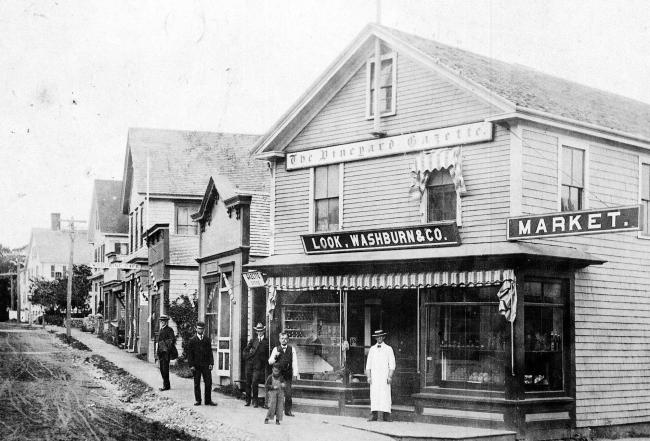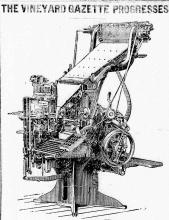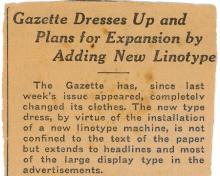James and Sally Fulton Reston, publishers of the Gazette, have announced plans to replace the paper’s traditional hot metal letterpress printing machinery with modern photocomposition equipment and a web offset press. Next Friday’s Gazette will be typeset and printed by the new method.
Though the change will be dramatic in the Gazette’s print shop there will be little differences in the appearance of the paper. It will remain a broadsheet of almost the same dimensions. While new typefaces will be added, some old ones will be kept. The paper’s traditional vertical makeup and column rules will stay too, as well the old fashioned logos over columns like Joseph Chase Allen’s With the Fishermen.
Change will be greatest in the matter of production. Speed and flexibility are hallmarks of photo-typesetting and offset printing equipment. The Gazette’s Linotype machines, operated by highly skilled men, can produces six or eight lines a minute. The new machines set type from coded paper tape at the rate of 60 lines per minute. The typewriter-like keyboards used to perforate the paper tape are quick enough to accommodate the speediest typists. The offset press will run off copies of the Gazette at the rate of 10,000 an hour - the Gazette’s faithful Duplex press now turns out finished papers at a more decorous pace, 2,500 per hour.
For some weeks to come, while we master the new equipment and while the old press is removed and the major renovation necessary for the installation of the new one is done, the Gazette will be printed in a Boston printing plant. This will involve no change in publication time, but there will be inconveniences we hope will be short-lived.
The new typesetting method is more difficult to describe than it is to understand. Typewritten news copy is retyped on a typewriter-like keyboard attached to an electronic mechanism which punches holes in paper tape, according to a code for each character or space or other function whose key or combination of keys has been pressed by the operator. When a complete story’s been reproduced to holes on the tape a computer-driven typesetter reads the code very quickly, justifies each line to the required column width, and using very high speed photography prints the finished product on long narrow strips of photographic paper. This is developed with chemicals and the latent image of the column of type becomes visible.
Inside the phototypesetter is a filmstrip which holds all the letters and numbers, upper and lower case, of the type face in which the copy is being set. The film strip is on a drum spinning at more than 1,800 revolutions per minute. Inside the drum are light bulbs of a sort which flash for microseconds only as the characters in the line to be composed pass each position.
Each light flash passes through the character on the film strip that is ordered by the coded tape, then through a shutter-prism assembly, then through an automatically positioned lens which controls the size of the resulting image and eventually to the photographic paper that’s moving in front of the lens.
When the computer-typesetter is busy there is a red light which tells you so. Most of us at the Gazette believe the new equipment is smarter than the old, and some are afraid it’s smarter than we are.
The strips of photographic paper with the printed columns of type, together with advertising layout and photographs are pasted on a page size board, and a large camera is used to take a photograph of each page. The negative that’s produced is used to make an image of the page on a thin aluminum plate which is strapped to the revolving drum of the press, and the process is completed.
When the Duplex press was installed in 1929 it was wondrously fast. The press run could be completed in less than an hour. This past summer Friday press runs often exceeded 11,000, and the number is sure to climb in years to come. The speed and capacity of the Duplex press and the speed of the Linotype machines make it difficult for the paper to grow in number of pages too. Time consuming composition and time consuming press runs impose limits on growth that the Gazette and the Island no longer respect.
And the pressure of growth doesn’t respect age either. Machinery as complex and as old as the Gazette’s press and Linotype equipment suffers breakdowns which are increasingly difficult and costly to repair. Neither the press nor the Linotype is manufactured in the United Sates any longer. Parts for the former if unavailable, as is generally the case, must be specifically cast, and for the Linotype parts must be ordered from Europe.
Parts from Europe, printers from England: skilled compositors and Linotype operators are becoming scarce too. This past fall when experiences printing assistance was needed in our back shop, advertisements in the United States proved fruitless, and Clifford Baker, an English printer, was given permission by United States immigration officials to join the Gazette for a brief period.
Small weekly newspapers which print on great flatbed letterpress machinery are rare. The New England Press Association reports that fewer than a dozen remain in Massachusetts. Among small papers which set type with photocomposition equipment few have offset presses of their own. They hire their printing out to large plants which print several different papers, a practice the Gazette will follow only until its new press is installed.









Comments